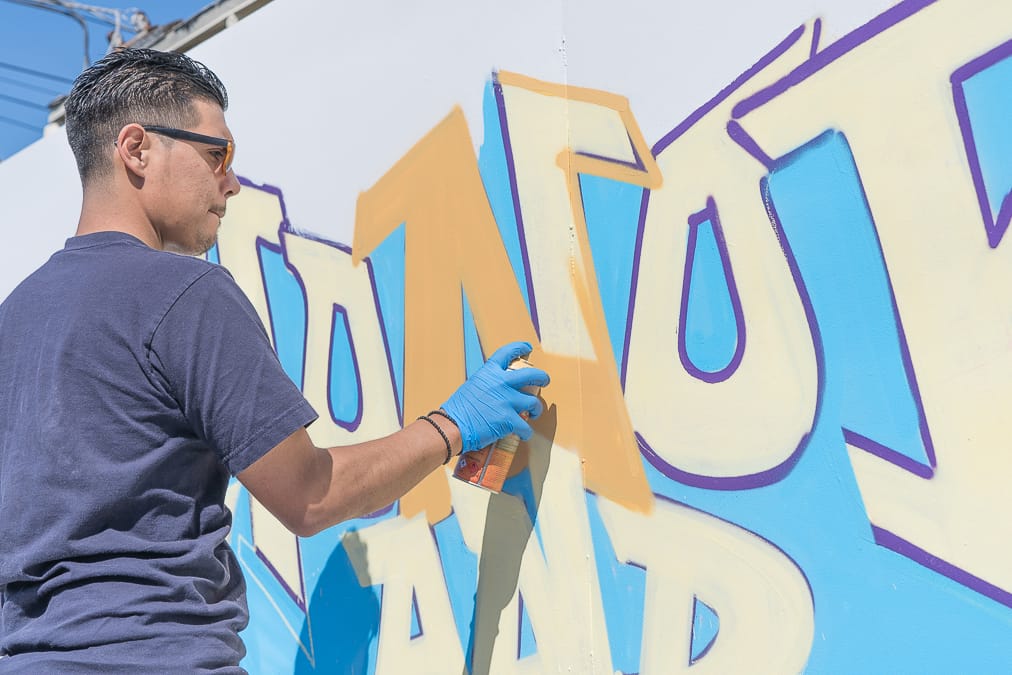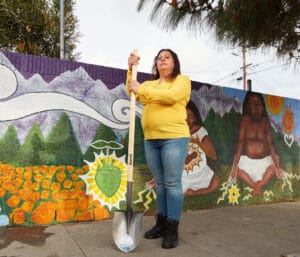Cities across the country are full of public places that no one wants to visit. They are paved over and often neglected. What if we could change that? By rethinking vacant lots and transforming alleys in Los Angeles, Trust for Public Land is creating a scalable model of green revitalization. Our Green Alleys work has enlisted community partners such as Equipo Verde to turn disregarded corridors into attractive, sustainable pathways.
When it comes to new parkland in the nation’s biggest cities, city leaders and residents need to get creative: think reclaiming a defunct rail line for use as bike path or transforming an asphalt schoolyard into a nature-filled play space. In Los Angeles, one untapped resource is the city’s network of alleys—900 miles of them.
But those alleys were designed long ago, without thought given to the tens of thousands of residents who would use them as thoroughfares. Compounding poor design are years of neglect, leaving them filled with trash, magnets for crime, and inhospitable to pedestrians.
Trust for Public Land, working with city agencies and local nonprofits, has started to turn these shunned spaces into linear parks, dotted with lemon trees, outfitted with new lighting, adorned with murals—and welcoming to all. Called Green Alleys, they are also engineered to capture and naturally filter rainwater so the underground aquifers in South L.A., important sources of drinking water, are replenished.
The result? A new network of pedestrian friendly corridors that do double duty as green infrastructure and sustainable thoroughfares. In March, Trust for Public Land celebrated the opening of the Central-Jefferson and Quincy Jones Green Alley networks. The two projects revitalized 11 underused alleyways in the historic Central Avenue jazz district.

A mural reading “Honor and Respect” is painted at the opening of the Central Quincy Green Alley network; TPL projects often incorporate local art and artists to embrace the identity of a neighborhood. Photo: Joe Sorrentino
More than 30,000 residents of South Los Angeles live within a 10-minute walk of the alleys, which, thanks to vegetation like flowering vines and espaliered trees, not only prevent flooding but counter urban heat. The Central Jefferson Green Alley network includes renovations to 0.62 linear miles of alleyway, while the Quincy Jones Green Alley network includes 0.17 linear miles, with both networks adjacent to local schools. The vibrant new alleys provide residents with a safe way to walk to school, access jobs, and run errands such as grocery shopping.
“Let’s take back something that’s going to be there for the kids in the long term.”
– Sonia Rodriguez, member of Equipo Verde
They were the latest in a series of Green Alleys TPL has worked on in recent years. In 2016, we repurposed nearly a mile of forbidding back alleys, now known as Avalon Green Alley, in the South Park neighborhood, and in 2020, we partnered with Pacoima Beautiful to unveil the Bradley Plaza and Green Alley in the Pacoima neighborhood. The plaza, previously a segment of Bradley Avenue, is now closed to vehicular traffic and includes a shade structure, fitness equipment, and an outdoor classroom.
Knitting the projects together was the crucial partnership between Trust for Public Land and Equipo Verde, a community group whose name means “Green Team” in English, and that has fiercely advocated for public funding and devoted weeknights and weekends to planting, painting, and trash removal.

Sonia Rodriguez, a member of Equipo Verde, has helped lead her community in reclaiming disregarded public spaces. Photo: Maria Noble
Sonia Rodriguez, a member of Equipo Verde and one of TPL’s Community Impact Heroes, says collaborating with TPL catapulted members into new leadership roles and deepened their activism in the community, whether around public education or crime prevention. She explained that she and a neighbor were inspired to take a course at the Urban Peace Institute, while other members wound up joining other nonprofit organizations.
The Green Alleys, she says, “brought a lot of resources to the community,” prompting her and fellow residents to ask, “Why not our school? Why not our city? Let’s take back something that’s going to be there for the kids in the long term.”
Donate today to support our work bringing innovative, healthy, green public spaces to cities in California.
With the effects of climate change bearing down on cities, Green Alleys are making neighborhoods more resilient too. While Los Angeles is generally dry, when there is precipitation, it tends to arrive in torrents, flooding streets and alleys. The Central Jefferson Green Alley network is expected to capture and filter 1,300,000 gallons of stormwater per year, and Quincy Jones 263,000 gallons. The green infrastructure features include basins for capturing stormwater and rain gardens with native plants that naturally filter pollutants.
“Natural climate solutions work,” says Guillermo Rodriguez, TPL’s California state director and vice president for the Pacific region, adding that neighborhoods with Green Alley projects have already seen reduced flooding.
The Green Alleys program in Los Angeles underscores the power of thinking creatively about existing urban infrastructure. Reclaiming forgotten spaces enhances neighborhoods and provides residents with new outdoor opportunities. Such areas not only improve public health by giving children room to play and adults sustainable ways to move around: they also foster social bonds that translate to more engaged communities.
Lisa W. Foderaro is a senior writer and researcher for Trust for Public Land. Previously, she was a reporter for the New York Times, where she covered parks and the environment.
Rising temperatures, bigger storms, and asphalt schoolyards pose significant risks during recess. Urge Congress to prioritize schoolyards that cool neighborhoods, manage stormwater, and provide opportunities for kids to connect with nature today!

Donate to become a member, and you’ll receive a subscription to Land&People magazine, our biannual publication featuring exclusive, inspiring stories about our work connecting everyone to the outdoors.

